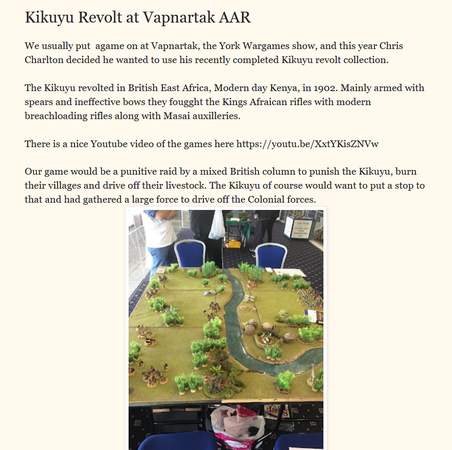
WARGAMES Terrain & Buildings
132 pages. Color photos throughout.
The latest book in this series is a guide to acquiring or constructing your own WWI tabletop trenches.
Douglas Hardy, the author, is a member of the Western Front Association and familiar with the battlefields of the Great War. He also claims to be an experienced gamer and modeller.
His emphasis is on practical wargaming, and the sections of this book are:
- Introduction
- Trenches throughout history, and how they were used in the Great War. (6 pages)
- Chapter 1: Wargaming the Great War
- Brief history of WWI miniature wargaming, overview of possible scenarios, and discussion of available scales. (2 pages)
- Chapter 2: Materials
- Listing of what you'll need if you build your own trench system: styrofoam, wood and sticks, string, glues, tools, modeling clay, paint, sand, flock, and brushes. Uses British terms and products. (9 pages)
- Chapter 3: Commercial or Scratch-Built?
- Pros and cons of building your trench system from scratch, versus acquiring commercial terrain products and painting them. (3 pages)
- Chapter 4: Building and Painting Commercial Scenery
- Lists available commercial products by scale, with painting tutorial (the same info is repeated in several places). For 15mm, he provides pictures of Ironclad Miniatures resin pieces, then shows how he paints them. For 20mm, he covers the vacuum-formed plastics from Early War Miniatures, with painting tutorial. For 28mm, the author looks at Ironclad Miniatures resin products and Amera vac-formed sci-fi (!) trenches, with painting tutorial and guide to adding detail (planking, sandbags, and wattling). Heavily illustrated. (47 pages)
- Chapter 5: Scratch-building
- How to make individual gameboards from styrofoam over MDF, designing the layout, how to carve styrofoam trenches and shellholes. Adding planking and other details. Painting tutorial. No man's land and barbed wire. (22 pages)
- Chapter 6: Projects
- Ideas for special terrain for the trenchline. Uses 20mm out-of-production Bellona vac-formed terrain to show making a fortified cellar and a stronghold with bunker. Making a shell-shattered woods and gun emplacements. (8 pages)
- Chapter 7: Researching First World War Trenches Today
- Guide to WWI trench exhibits in France. Heavily illustrated. (29 pages)
The best thing about this book is the large amount of photos showing the author's own trench systems, both in progress and finished. The many photos of actual trenches are also appreciated.
One problem is that the author fails to provide a complete overview of WWI trenches, how they were laid out, and what their features are. He uses technical terms which he doesn't explain. He refers to aerial photos that show how the trenches were laid out, but provides no examples (and in fact, no contemporary photos at all). Instead, he sprinkles bits of information throughout the text.
The book is also poorly organized. It seems odd to have the historical reference material at the end, when it would have been much more useful at the start. Painting information is repeated in different sections.
While the book claims to cover all of WWI, the focus is clearly on late-war Western Front British and German trenches. We're told that French trenches were sort of a mix of German and British styles (?). Trenches for other periods and fronts are only mentioned briefly (i.e., Turkish trenches had log cover). He fails to cover building terrain to a particular ground scale, but mentions some tips with regard to figure scale.
The author clearly has a preferred painting style. Trenches are basecoated brown with two layers of drybrushing; wood can be painted a variety of colors; sandbags are painted in lighter colors. This is certainly a useful approach, and it looks nice on a tabletop, but it does not match the color photos of actual trenches in the book. It would have been useful if he had explained the discrepancies.
Although the author mentions 6mm and 10mm scales, as well as divisional-level games, he provides no further information. He briefly mentions terrain products from Javis, Kallistra and Battlefront; he does not mention the option of pre-painted terrain pieces.
There's a lot to like about this book, particularly the pictures of actual trenches today and the author's terrain systems. I had the feeling that the author was competent in this field, but had difficulty sharing his knowledge in an organized fashion. Most of the information is aimed at the 28mm skirmish gamer.
Useful but frustrating resource.
Reviewed by ![]() Editor in Chief Bill
Editor in Chief Bill ![]()
![]() .
.







